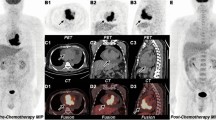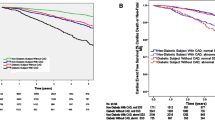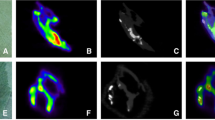Abstract
In 2019, the Journal of Nuclear Cardiology published excellent articles pertaining to imaging in patients with cardiovascular disease. In this review we will summarize a selection of these articles to provide a concise review of the main advancements that have recently occurred in the field and provide the reader with an opportunity to review a wide selection of articles. In this first article of this 2-part series we will focus on publications dealing with positron emission tomography, computed tomography and magnetic resonance. We will specifically discuss imaging as it relates to coronary artery disease, atherosclerosis and inflammation, coronary artery calcification, cardiomyopathies, cardiac implantable electronic devices, prosthetic valves, and left ventricular assist devices. The second part of this review will place emphasis on myocardial perfusion imaging using single-photon emission computed tomography.



Similar content being viewed by others
References
AlJaroudi WA, Hage FG. Review of cardiovascular imaging in the Journal of Nuclear Cardiology 2018. Part 1 of 2: Positron emission tomography, computed tomography, and magnetic resonance. J Nucl Cardiol 2019;26:524-35.
Hage FG, AlJaroudi WA. Review of cardiovascular imaging in the Journal of Nuclear Cardiology in 2017. Part 2 of 2: Myocardial perfusion imaging. J Nucl Cardiol 2018;25:1390-9.
AlJaroudi WA, Hage FG. Review of cardiovascular imaging in the Journal of Nuclear Cardiology 2017. Part 1 of 2: Positron emission tomography, computed tomography, and magnetic resonance. J Nucl Cardiol 2018;25:320-30.
Hage FG, AlJaroudi WA. Review of cardiovascular imaging in the journal of nuclear cardiology in 2016: Part 2 of 2-myocardial perfusion imaging. J Nucl Cardiol 2017;24:1190-9.
AlJaroudi W, Hage FG. Review of cardiovascular imaging in the Journal of Nuclear Cardiology in 2016. Part 1 of 2: Positron emission tomography, computed tomography and magnetic resonance. J Nucl Cardiol 2016;2017(24):649-56.
Hage FG, AlJaroudi WA. Review of cardiovascular imaging in the Journal of Nuclear Cardiology in 2015-Part 2 of 2: Myocardial perfusion imaging. J Nucl Cardiol 2016;23:493-8.
AlJaroudi WA, Hage FG. Review of cardiovascular imaging in the journal of nuclear cardiology in 2015. Part 1 of 2: Plaque imaging, positron emission tomography, computed tomography, and magnetic resonance. J Nucl Cardiol 2015;2016(23):122-30.
Hage FG, AlJaroudi WA. Review of cardiovascular imaging in the Journal of Nuclear Cardiology in 2014: Part 2 of 2: Myocardial perfusion imaging. J Nucl Cardiol 2015;22:714-9.
AlJaroudi WA, Hage FG. Review of cardiovascular imaging in the Journal of Nuclear Cardiology in 2014: Part 1 of 2: Positron emission tomography, computed tomography, and neuronal imaging. J Nucl Cardiol 2015;22:507-12.
Greenspon AJ, Patel JD, Lau E, Ochoa JA, Frisch DR, Ho RT, et al. 16-year trends in the infection burden for pacemakers and implantable cardioverter-defibrillators in the United States 1993 to 2008. J Am Coll Cardiol 2011;58:1001-6.
Greenspon AJ, Patel JD, Lau E, Ochoa JA, Frisch DR, Ho RT, et al. Trends in permanent pacemaker implantation in the United States from 1993 to 2009: Increasing complexity of patients and procedures. J Am Coll Cardiol 2012;60:1540-5.
Sarrazin JF, Trottier M, Tessier M. Accuracy of PET/CT for detection of infective endocarditis: Where are we now? J Nucl Cardiol 2019;26:936-8.
Priori SG, Blomstrom-Lundqvist C, Mazzanti A, Blom N, Borggrefe M, Camm J, et al 2015 ESC Guidelines for the management of patients with ventricular arrhythmias and the prevention of sudden cardiac death: The Task Force for the Management of Patients with Ventricular Arrhythmias and the Prevention of Sudden Cardiac Death of the European Society of Cardiology (ESC). Endorsed by: Association for European Paediatric and Congenital Cardiology (AEPC). Eur Heart J 2015;36:2793-867.
Mahmood M, Kendi AT, Ajmal S, Farid S, O’Horo JC, Chareonthaitawee P, et al. Meta-analysis of 18F-FDG PET/CT in the diagnosis of infective endocarditis. J Nucl Cardiol 2019;26:922-35.
Mahmood M, Kendi AT, Farid S, Ajmal S, Johnson GB, Baddour LM, et al. Role of (18)F-FDG PET/CT in the diagnosis of cardiovascular implantable electronic device infections: A meta-analysis. J Nucl Cardiol 2019;26:958-70.
de Vaugelade C, Mesguich C, Nubret K, Camou F, Greib C, Dournes G, et al. Infections in patients using ventricular-assist devices: Comparison of the diagnostic performance of (18)F-FDG PET/CT scan and leucocyte-labeled scintigraphy. J Nucl Cardiol 2019;26:42-55.
Legallois D, Manrique A. Diagnosis of infection in patients with left ventricular assist device: PET or SPECT? J Nucl Cardiol 2019;26:56-8.
Kanapinn P, Burchert W, Korperich H, Korfer J. (18)F-FDG PET/CT-imaging of left ventricular assist device infection: A retrospective quantitative intrapatient analysis. J Nucl Cardiol 2019;26:1212-21.
Hyafil F, Rouzet F, Benali K. FDG-PET for the detection of infection in left ventricle assist device: Is there light at the end of the tunnel? J Nucl Cardiol 2019;26:1222-4.
Rudd JH, Warburton EA, Fryer TD, Jones HA, Clark JC, Antoun N, et al. Imaging atherosclerotic plaque inflammation with [18F]-fluorodeoxyglucose positron emission tomography. Circulation 2002;105:2708-11.
Sadeghi MM. (18)F-FDG PET and vascular inflammation: Time to refine the paradigm? J Nucl Cardiol 2015;22:319-24.
Tavakoli S. Technical considerations for quantification of (18)F-FDG uptake in carotid atherosclerosis. J Nucl Cardiol 2019;26:894-8.
Johnsrud K, Skagen K, Seierstad T, Skjelland M, Russell D, Revheim ME. (18)F-FDG PET/CT for the quantification of inflammation in large carotid artery plaques. J Nucl Cardiol 2019;26:883-93.
Yang F, Luo J, Hou Q, Xie N, Nie Z, Huang W, et al. Predictive value of (18)F-FDG PET/CT in patients with acute type B aortic intramural hematoma. J Nucl Cardiol 2019;26:633-41.
Soussan M, Hyafil F. Can FDG-PET imaging play a role in guiding indications to endovascular treatments in patients presenting acute aortic syndromes? J Nucl Cardiol 2019;26:642-4.
Lawal IO, Ankrah AO, Popoola GO, Lengana T, Sathekge MM. Arterial inflammation in young patients with human immunodeficiency virus infection: A cross-sectional study using F-18 FDG PET/CT. J Nucl Cardiol 2019;26:1258-65.
Tawakol A, Migrino RQ, Bashian GG, Bedri S, Vermylen D, Cury RC, et al. In vivo 18F-fluorodeoxyglucose positron emission tomography imaging provides a noninvasive measure of carotid plaque inflammation in patients. J Am Coll Cardiol 2006;48:1818-24.
Rominger A, Saam T, Wolpers S, Cyran CC, Schmidt M, Foerster S, et al. 18F-FDG PET/CT identifies patients at risk for future vascular events in an otherwise asymptomatic cohort with neoplastic disease. J Nucl Med 2009;50:1611-20.
Mikail N, Sinigaglia M, Hyafil F. Could FDG-PET imaging play a role in the detection of progressing atherosclerosis in HIV-infected patients? J Nucl Cardiol 2019;26:1266-8.
Lee SW, Kim SJ, Seo Y, Jeong SY, Ahn BC, Lee J. F-18 FDG PET for assessment of disease activity of large vessel vasculitis: A systematic review and meta-analysis. J Nucl Cardiol 2019;26:59-67.
Hartzes AM, Morgan CJ. Meta-analysis for diagnostic tests. J Nucl Cardiol 2019;26:68-71.
Hop H, de Boer SA, Reijrink M, Kamphuisen PW, de Borst MH, Pol RA, et al. (18)F-sodium fluoride positron emission tomography assessed microcalcifications in culprit and non-culprit human carotid plaques. J Nucl Cardiol 2019;26:1064-75.
Giannopoulos AA, Benz DC, Grani C, Buechel RR. Imaging the event-prone coronary artery plaque. J Nucl Cardiol 2019;26:141-53.
Tuominen H, Haarala A, Tikkakoski A, Korkola P, Kahonen M, Nikus K, et al. (18)F-FDG-PET in Finnish patients with clinical suspicion of cardiac sarcoidosis: Female sex and history of atrioventricular block increase the prevalence of positive PET findings. J Nucl Cardiol 2019;26:394-400.
Kouranos V, Wechalekar K. Search for key manifestations to predict inflammation on cardiac PET in suspected cardiac sarcoidosis population. J Nucl Cardiol 2019;26:401-4.
Hage FG. Hybrid positron emission tomography-magnetic resonance imaging for cardiac sarcoid. J Nucl Cardiol 2019;26:2005-6.
Ahluwalia M, Pan S, Ghesani M, Phillips LM. A new era of imaging for diagnosis and management of cardiac sarcoidosis: Hybrid cardiac magnetic resonance imaging and positron emission tomography. J Nucl Cardiol 2019;26:1996-2004.
Patel DC, Gunasekaran SS, Goettl C, Sweiss NJ, Lu Y. FDG PET-CT findings of extra-thoracic sarcoid are associated with cardiac sarcoid: A rationale for using FGD PET-CT for cardiac sarcoid evaluation. J Nucl Cardiol 2019;26:486-92.
Valentin RC, Bhambhvani P. The logic and challenges of imaging sarcoidosis with whole body FDG PET. J Nucl Cardiol 2019;26:493-6.
Kumita S, Yoshinaga K, Miyagawa M, Momose M, Kiso K, Kasai T. Recommendations for (18)F-fluorodeoxyglucose positron emission tomography imaging for diagnosis of cardiac sarcoidosis-2018 update: Japanese Society of Nuclear Cardiology recommendations. J Nucl Cardiol 2019;26:1414-33.
Bravo PE, Singh A, Di Carli MF, Blankstein R. Advanced cardiovascular imaging for the evaluation of cardiac sarcoidosis. J Nucl Cardiol 2019;26:188-99.
Dorbala S, Shaw LJ. Molecular phenotyping of infiltrative cardiomyopathies: The future. J Nucl Cardiol 2019;26:154-7.
Bengel FM, Ross TL. Emerging imaging targets for infiltrative cardiomyopathy: Inflammation and fibrosis. J Nucl Cardiol 2019;26:208-16.
Imbriaco M, Nappi C, Puglia M, De Giorgi M, Dell’Aversana S, Cuocolo R, et al. Assessment of acute myocarditis by cardiac magnetic resonance imaging: Comparison of qualitative and quantitative analysis methods. J Nucl Cardiol 2019;26:857-65.
Farris GR, Lloyd SG. The search for water: Is it so easy to diagnose acute myocarditis? J Nucl Cardiol 2019;26:866-8.
Nensa F, Kloth J, Tezgah E, Poeppel TD, Heusch P, Goebel J, et al. Feasibility of FDG-PET in myocarditis: Comparison to CMR using integrated PET/MRI. J Nucl Cardiol 2018;25:785-94.
Rischpler C, Langwieser N, Nekolla SG. Cardiac PET/MRI enters the clinical arena! Finally. J Nucl Cardiol 2018;25:795-6.
Bravo PE. Is there a role for cardiac positron emission tomography in hypertrophic cardiomyopathy? J Nucl Cardiol 2019;26:1125-34.
Kay GN. Can positron emission tomography help stratify the risk of sudden cardiac death in patients with hypertrophic cardiomyopathy? J Nucl Cardiol 2019;26:1135-7.
Calnon DA. Will (18)F flurpiridaz replace (82)rubidium as the most commonly used perfusion tracer for PET myocardial perfusion imaging? J Nucl Cardiol 2019;26:2031-3.
Maddahi J, Bengel F, Czernin J, Crane P, Dahlbom M, Schelbert H, et al. Dosimetry, biodistribution, and safety of flurpiridaz F 18 in healthy subjects undergoing rest and exercise or pharmacological stress PET myocardial perfusion imaging. J Nucl Cardiol 2019;26:2018-30.
Moody JB, Hiller KM, Lee BC, Poitrasson-Riviere A, Corbett JR, Weinberg RL, et al. The utility of (82)Rb PET for myocardial viability assessment: Comparison with perfusion-metabolism (82)Rb-(18)F-FDG PET. J Nucl Cardiol 2019;26:374-86.
Ananthasubramaniam K, Arumugam P. Quantitative (82)Rb dynamic pet perfusion analysis with kinetic modeling for myocardial viability: Can we get away with just (82)Rb perfusion kinetics? J Nucl Cardiol 2019;26:387-90.
Ghotbi AA, Hasbak P, Nepper-Christensen L, Lonborg J, Atharovski K, Christensen T, et al. Early risk stratification using Rubidium-82 positron emission tomography in STEMI patients. J Nucl Cardiol 2019;26:471-82.
Slart R, Juarez-Orozco LE. Early post-STEMI PET, a judicious investment? J Nucl Cardiol 2019;26:483-5.
Wang L, Lu MJ, Feng L, Wang J, Fang W, He ZH, et al. Relationship of myocardial hibernation, scar, and angiographic collateral flow in ischemic cardiomyopathy with coronary chronic total occlusion. J Nucl Cardiol 2019;26:1720-30.
Bax JJ, Delgado V. Chronic total occlusion without collateral blood flow does not exclude myocardial viability and subsequent recovery after revascularization. J Nucl Cardiol 2019;26:1731-3.
Monroy-Gonzalez AG, Tio RA, de Groot JC, Boersma HH, Prakken NH, De Jongste MJL, et al. Long-term prognostic value of quantitative myocardial perfusion in patients with chest pain and normal coronary arteries. J Nucl Cardiol 2019;26:1844-52.
Schumann C, Bourque JM. Coronary microvascular dysfunction: Filling the research gaps with careful patient selection. J Nucl Cardiol 2019;26:1853-6.
Ghannam M, Mikhova K, Yun HJ, Lazarus JJ, Konerman M, Saleh A, et al. Relationship of non-invasive quantification of myocardial blood flow to arrhythmic events in patients with implantable cardiac defibrillators. J Nucl Cardiol 2019;26:417-27.
Velasco A, Doppalapudi H. Noninvasive myocardial blood flow assessment: Another marker of arrhythmic risk? J Nucl Cardiol 2019;26:428-30.
AlJaroudi W, Mansour MJ, Chedid M, Hamoui O, Asmar J, Mansour L, et al. Incremental value of stress echocardiography and computed tomography coronary calcium scoring for the diagnosis of coronary artery disease. Int J Cardiovasc Imaging 2019;35:1133-9.
Nappi C, Gaudieri V, Acampa W, Arumugam P, Assante R, Zampella E, et al. Coronary vascular age: An alternate means for predicting stress-induced myocardial ischemia in patients with suspected coronary artery disease. J Nucl Cardiol 2019;26:1348-55.
Yokota S, Mouden M, Ottervanger JP, Engbers E, Jager PL, Timmer JR, et al. Coronary calcium score influences referral for invasive coronary angiography after normal myocardial perfusion SPECT. J Nucl Cardiol 2019;26:602-12.
Mansour MJ, Chammas E, Hamoui O, Honeine W, AlJaroudi W. Association between left ventricular diastolic dysfunction and subclinical coronary artery calcification. Echocardiography 2020;37:253-9.
He BJ, Malm BJ, Carino M, Sadeghi MM. Prevalence and variability in reporting of clinically actionable incidental findings on attenuation-correction CT scans in a veteran population. J Nucl Cardiol 2019;26:1688-93.
Port S. Incidental findings on hybrid SPECT-CT and PET-CT scanners: Is it time for new training and reporting guidelines? J Nucl Cardiol 2019;26:1694-6.
Harnett DT, Hazra S, Maze R, Mc Ardle BA, Alenazy A, Simard T, et al. Clinical performance of Rb-82 myocardial perfusion PET and Tc-99m-based SPECT in patients with extreme obesity. J Nucl Cardiol 2019;26:275-83.
Rasmussen T, Kjaer A, Hasbak P. Stomach interference in (82)Rb-PET myocardial perfusion imaging. J Nucl Cardiol 2019;26:1934-42.
Rimoldi O. Striving to improve (82)Rubidium PET MPI accuracy. J Nucl Cardiol 2019;26:1943-5.
Renaud JM, Wu KY, Gardner K, Aung M, Beanlands RSB, deKemp RA. Saline-push improves rubidium-82 PET image quality. J Nucl Cardiol 2019;26:1869-74.
Aggarwal NR. Optimizing radionuclide protocols: Dotting our I’s and crossing our T’s. J Nucl Cardiol 2019;26:1875-7.
Klein R, Ocneanu A, Renaud JM, Ziadi MC, Beanlands RSB, deKemp RA. Consistent tracer administration profile improves test-retest repeatability of myocardial blood flow quantification with (82)Rb dynamic PET imaging. J Nucl Cardiol 2018;25:929-41.
Case J. Accurate myocardial blood flow measurements: Quality from start to finish is key to success. J Nucl Cardiol 2018;25:942-6.
Lassen ML, Rasul S, Beitzke D, Stelzmuller ME, Cal-Gonzalez J, Hacker M, et al. Assessment of attenuation correction for myocardial PET imaging using combined PET/MRI. J Nucl Cardiol 2019;26:1107-18.
Zaidi H, Nkoulou R. Artifact-free quantitative cardiovascular PET/MR imaging: An impossible dream? J Nucl Cardiol 2019;26:1119-21.
Barton GP, Vildberg L, Goss K, Aggarwal N, Eldridge M, McMillan AB. Simultaneous determination of dynamic cardiac metabolism and function using PET/MRI. J Nucl Cardiol 2019;26:1946-57.
Tamaki N, Matsushima S, Nishimura M. Value of simultaneous assessment of cardiac functions by PET/MRI. J Nucl Cardiol 2019;26:1958-61.
Disclosure
Dr. Hage reports research grant support from Astellas Pharma and GE Healthcare. Dr. AlJaroudi reports no disclosures.
Author information
Authors and Affiliations
Corresponding author
Additional information
Publisher's Note
Springer Nature remains neutral with regard to jurisdictional claims in published maps and institutional affiliations.
Rights and permissions
About this article
Cite this article
AlJaroudi, W.A., Hage, F.G. Review of cardiovascular imaging in the Journal of Nuclear Cardiology 2019: Positron emission tomography, computed tomography and magnetic resonance. J. Nucl. Cardiol. 27, 921–930 (2020). https://doi.org/10.1007/s12350-020-02151-y
Received:
Accepted:
Published:
Issue Date:
DOI: https://doi.org/10.1007/s12350-020-02151-y




